What is so special about learning how to hold a camera? You might be surprised what a big difference it can make. Holding your camera the correct way will allow for more comfortable shooting and sharper images.
In our beginners classes, we observe that more than 99% of our students make at least one of the mistakes listed below. Do you? This might be the reason why you sometimes end up with blurry images or don’t feel so comfortable taking pictures.
The overall principle is to have your left arm act as a monopod, carrying the weight of the camera. The right hand holds the camera comfortably, moving up for vertical shots while keeping the left hand steady. The left hand changes the zoom.
The earlier you develop good camera-holding habits, the better. It will be much harder to change bad habits as you progress in photography.
If you already know how to hold a camera, check our recommendations article on choosing the right camera for beginners.
Infographic:
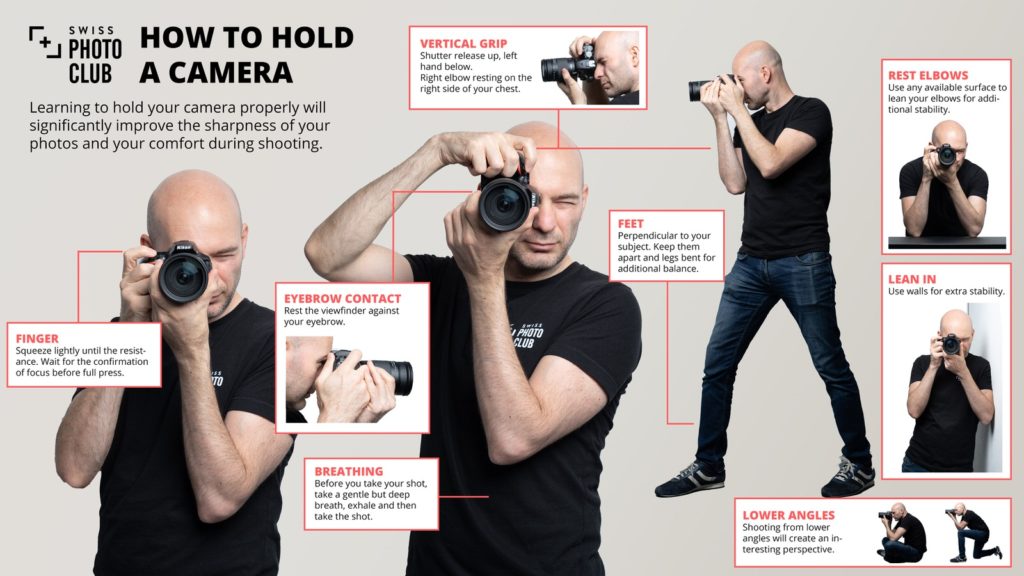
Want to share this image? You can do so by copy / pasting this code in your website:
<p><strong>Please include attribution to Swiss Photo Club with this graphic.</strong><br /><br /><a href='https://blog.swissphotoclub.com/en/how-to-hold-a-camera-properly/'><img src='https://blog.swissphotoclub.com/wp-content/uploads/2020/05/How-to-hold-a-camera-en.jpg' alt='How to hold a camera' width='800px' border='0' /></a></p>How to hold a camera: 10 rules
Left hand below the lens, not on the side
Avoid the “butterfly position”! The most common mistake we see with beginners, as they try to hold a DSLR like a phone camera.
The left hand should hold the lens from underneath with the thumb facing out. Firm, but not too tight. The left elbow rests on the side of the chest for stability. Tuck your elbows.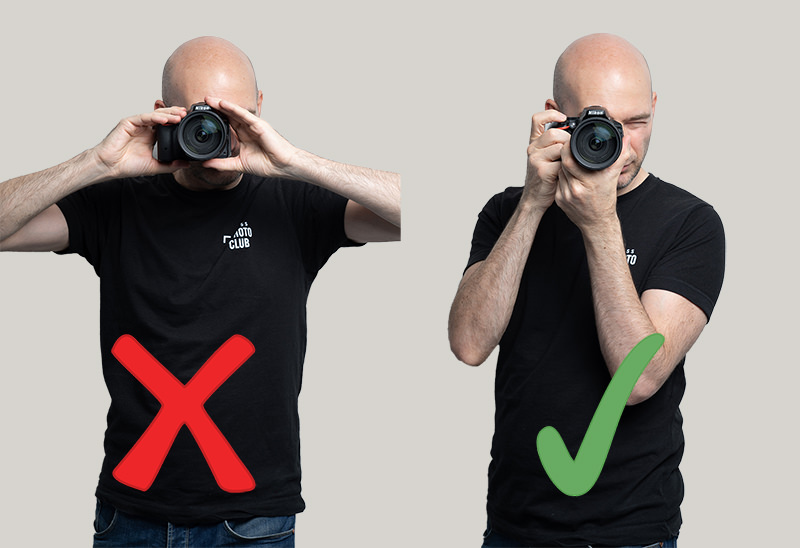
Vertical grip: Hold your camera with your right hand up
To shoot vertically, position your shutter release up, with your right elbow up. Your left hand stays below and doesn’t move. 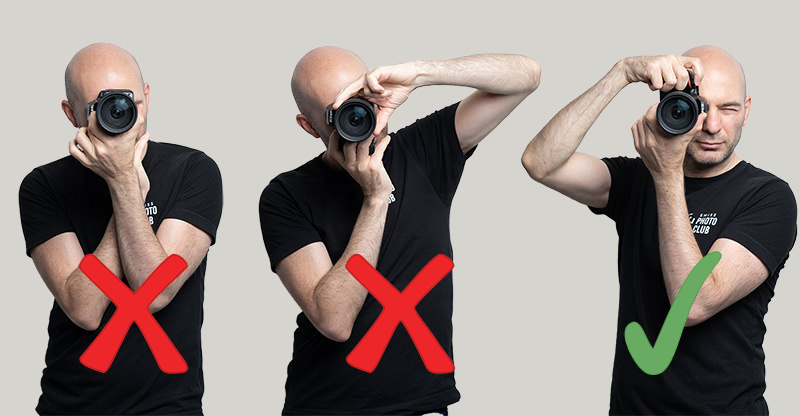
Eyebrow contact
Resting the camera on your eyebrow (unless you’re wearing eyeglasses) will help the stability further by creating a third point of contact. 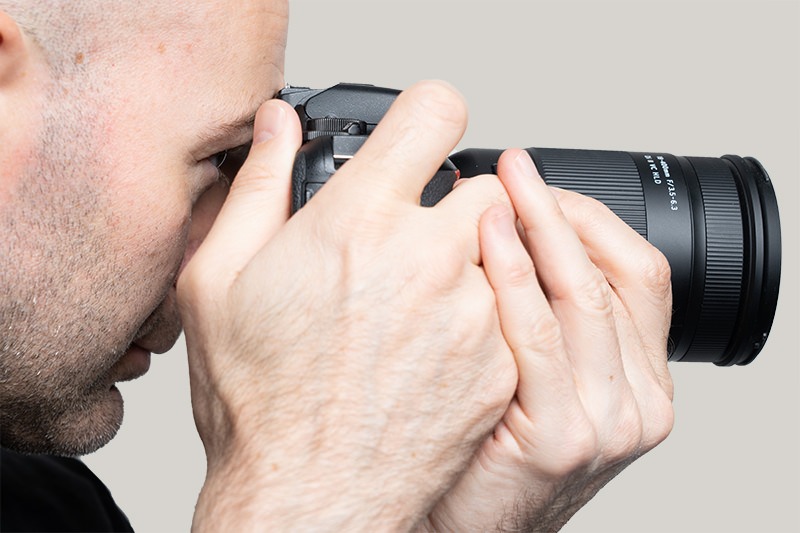
Tuck your elbows, and use the viewfinder.
Keep your elbows tucked, so that your elbows are anchored to your chest. This stops the elbows from their natural shake and also allows you to move your left hand under the lens to give it more support. If your camera has a viewfinder, you will find that holding the camera to your face will make it easier to stabilize the setup.
Right hand index finger relaxed on the shutter
To take a picture, squeeze the shutter lightly until you feel the resistance. Wait there for the focus confirmation before full press. A light push is enough; there is no need to press too hard.
Feet apart, left side to your subject
With your side to your subject, you will be able to rest your left elbow to the left side of your chest. Keep your feet apart for additional balance.
Lean towards your subject
We are not sure exactly why, but many students tend to lean backwards while taking a photo. For better stability and for your subject not to feel that you’re shying away from them, have a stable stance and lean slightly forward towards your subject.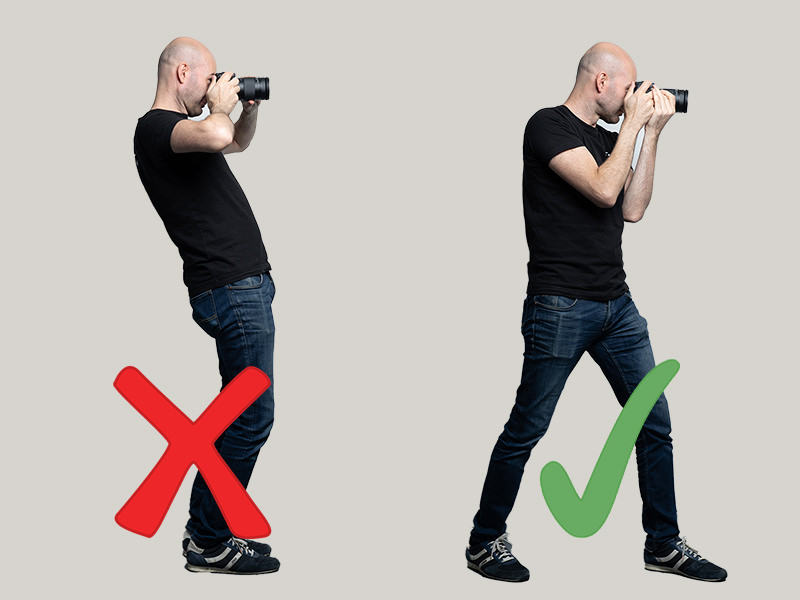
Exhale, then shoot
Take a breath, exhale, and then take the shot. The best time to take the shot is during what’s called the “respiratory pause.” This is when you’re done exhaling: the most stable moment.
Lower angles
While shooting from lower angles, use the opportunity to create extra support by resting your elbows on your knees. 
Use anything as a support
If there’s a wall, lean on it. If there’s a table, put your elbows on it. The more support you can create for your arms, the better.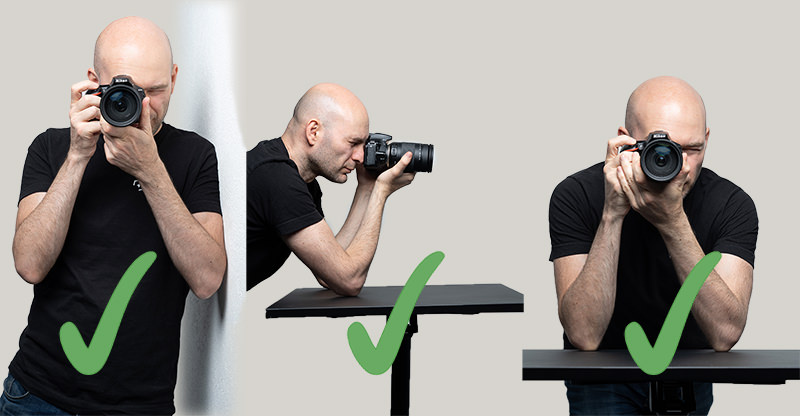
Hope that helps! With these new habits, you will take sharper pictures and feel much better after a long day of shooting.
Now that you know how to hold your camera correctly, go ahead and check our article on how to learn photography. Or you can skip straight ahead to checking out our in-person photography courses.




First things first, though… Most cameras are designed for people who are right handed to operate. So the shutter release is on the right hand side. Therefore, we always use our first finger on the right hand to press the shutter – unless we are using rear button focussing, of course. Which means that image #5 and the infographic are wrong, as both have someone holding the camera so that their finger can’t reach the shutter button. Sorry.
I don’t understand your comment, in all the recommended positions, the right index finger is comfortably on the shutter button.
When shooting vertical. Unless you are using a pancake lens or your grip is very small, it is better to hold your camera in position 1 which is left of the photo. It allows your arm to not open out like chicken wing and reduce shake when depressing the shutter button. Left hand on the base on the camera and lens, the hand should be in a position where the front and rear isn’t too much different, you should be able to hold the camera like a balance from the bottom, right hand is on the grip and shutter. Most… Read more »
Indeed it’s always better to get a battery grip for vertical. However I don’t agree that pos #1 is better, as your right hand would be pressing the shutter button while carrying the weight of the camera at the same time. In any case, however you feel comfortable is the best option for you 🙂 These are just recommendations for beginners.
As a concert pit photographer, I highly appreciate any co-photog who holds the camera with the shutter at the bottom when shooting vertically. This minimizes the chance of your arm and elbow blocking my shot. I fail to see how this is an unacceptable way to hold a camera.
Hi Birgit, in your case, it’s obviously better for the co-photog to hold it the other way. I never claimed it’s “unacceptable”, these are just the recommendations for general use. Thank you for your comment 🙂